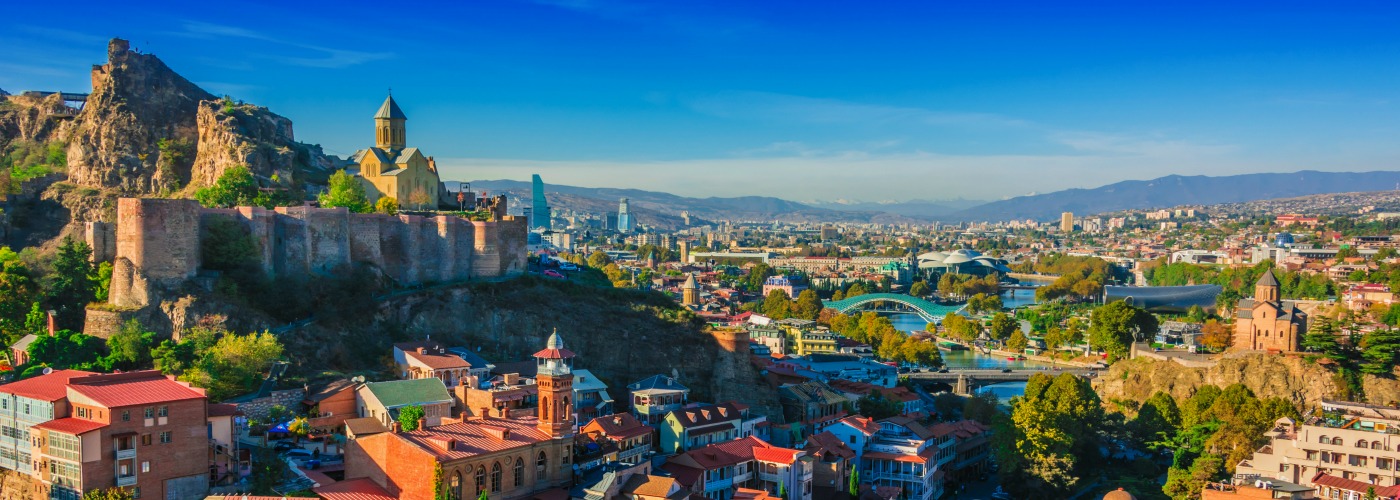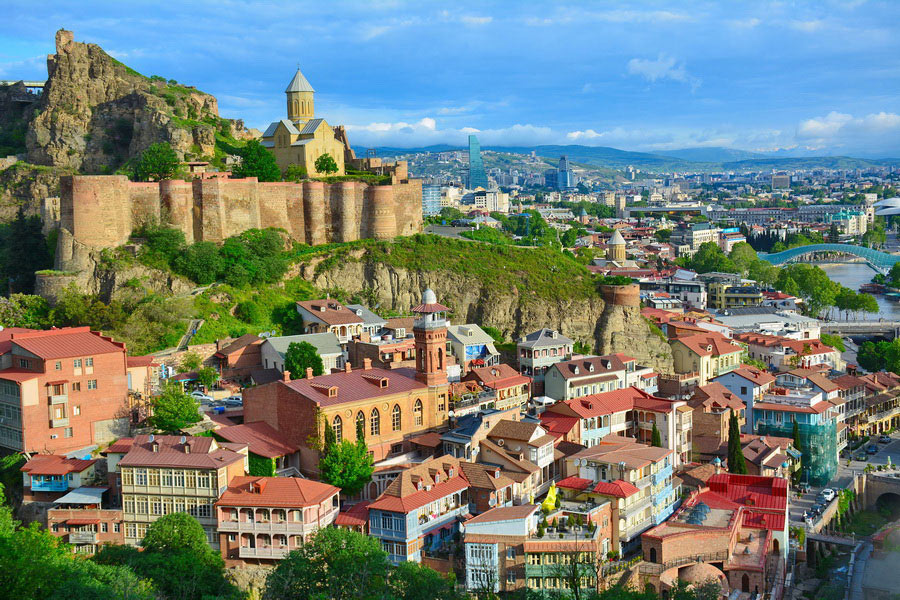we go to the most famous symbol of the city of Tbilisi .Tbilisi is the capital of the country of Georgia
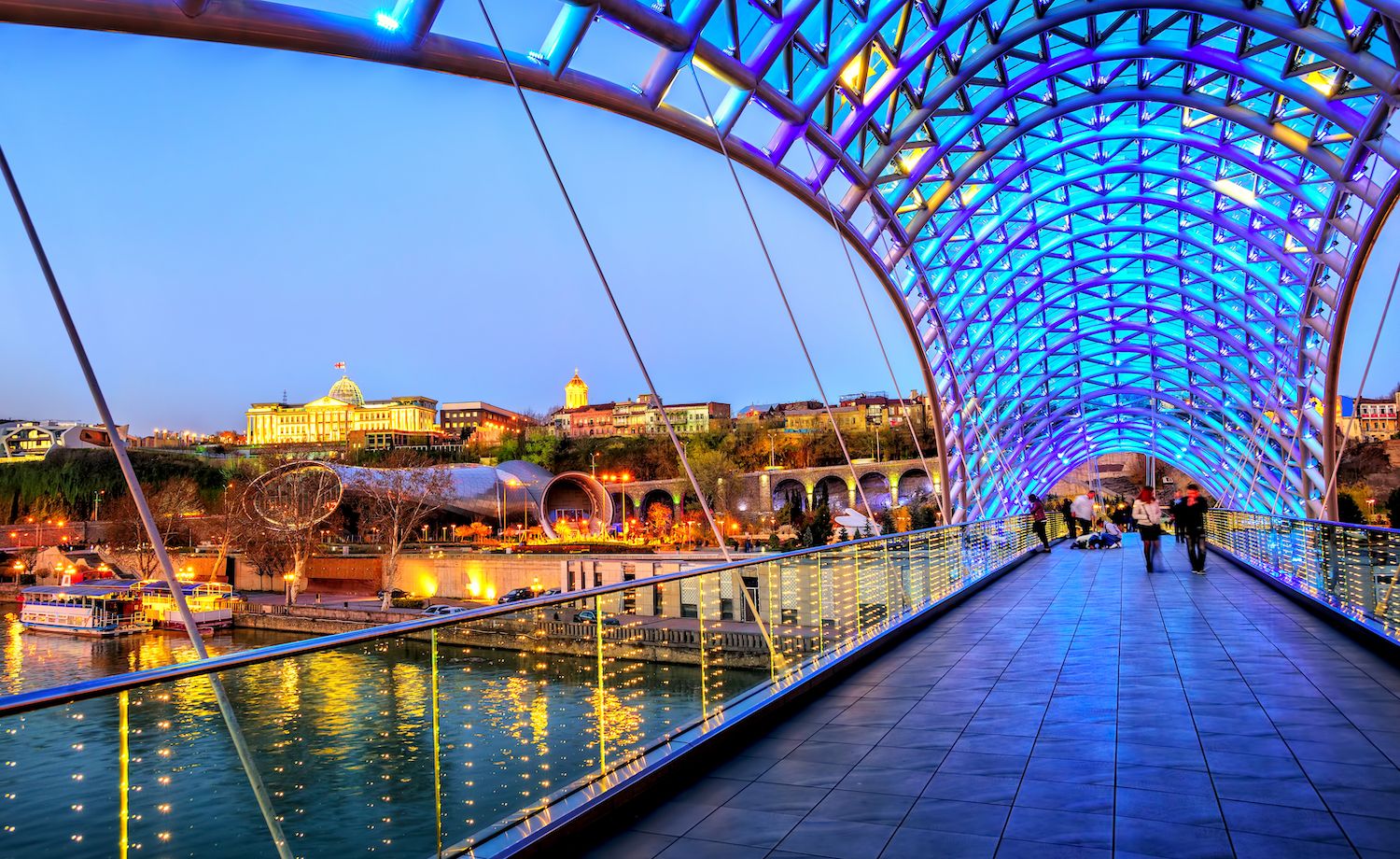
1.Bridge of Peace In Georgian :
this bridge is called “mshvidobis khidi”. The 150m long arching bridge is made of steel and glass and is embezzled with numerous LEDs and lights. This wonderful landmark is located in the center of Tbilisi, on the Kura River, and connects old and new Tbilisi. The bridge was officially opened on May 6, 2010. Strolling atop the bridge gives you a breathtaking view of the Mtkhi Cathedral, the statue of King Vakhtang Gorgasali and the Narikala Castle on the one side , and the Baratashvili Bridge and the Presidential Office building, on the other. Of course, the bridge structure, with the use of thousands of LEDs in the walls and lights in its curved curtain, attracts the eye of every tourist at night. Interestingly, the design of the bridge was done by Michael Dolcichi an Italian, and lighting by French philosopher Martínez The construction of this huge structure took place in Italy it was then moved to Tbilisi by land.
2.Narikala castle :
overlooking the city of Tbilisi and the river Kura. This castle is on a steep slope of a hill, consisting of two sections, the sulfur baths and the Tbilisi Botanical Garden separated by walls. A 13th century castle once stood at the base of the castle, where it burned down and was eventually replaced, in 1996 and 1997, by the St. Nicholas church. The interior walls of this church are depicted in pictures of Georgian history as well as narrations of the Bible. This castle was built in the 4th century AD in the style of Iranian architecture, and was considered by the King of David in the seventeenth century as part of the Umayyad caliphate The moguls did not miss this monument in their attack on the city and renamed it to Narikala (small castle). Many of the remains of this castle, which are visited by tourists today, are related to the 16th and 17th centuries, and the rest of it has been lost in various wars. Parts of the castle were damaged in the earthquake that rocked the city of Tbilisi in 1827.
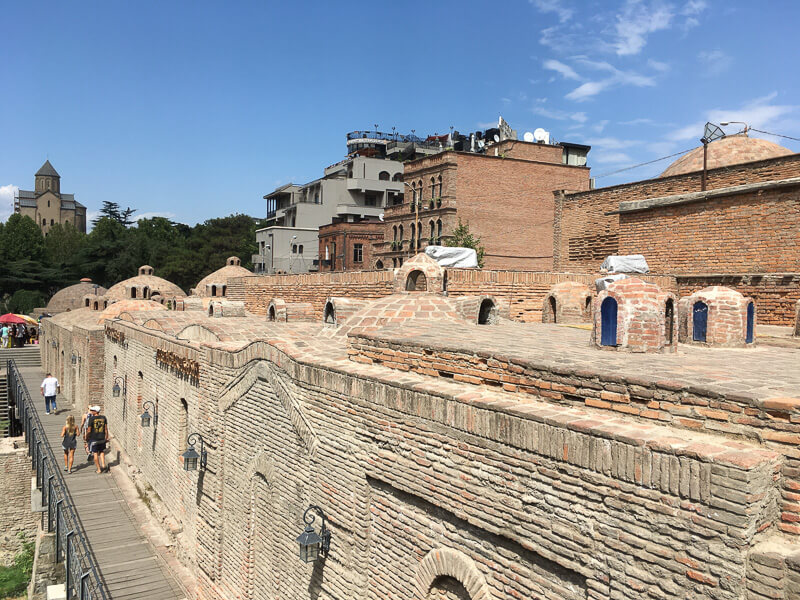
Historical discussions Tbilisi:
Vakhtang was one of the last Kings of Iberia, who reigned in the 5th century, and was of the Chosroid Dynasty who were a dynasty of Iranian Mihranid origin, accepted Christianity as their official religion, and maneuvered the Byzantine Empire and Sassanid Iran to retain a degree of independence. Vakhtang I has always been an endeared historical figure of Georgian culture, even referred to as a Saint by the Georgian Church. There are many recorded names in different historical text when referring to Vakhtang I, among which are Gorgasali meaning “Wolf-bodied” -with possible references to the wolf cult of Georgia or the wolf shaped hat that he wore, and the Persian name Varaz Khosrovtang which is said to have been rendered Vakhtang in Georgian. Vakhtang I was born in 440 AD in Mtskheta to Mihrdad V -a Georgian King and Sagdukht, a Persian Princess. He later married the Sassanid Princess Balendukht at the age of 19. It is said that King Vakhtang I gave chase to a Pheasant The King’s falcon allegedly caught or injured a pheasant during the hunt, after which both birds fell into a nearby hot spring and died from burns He dazzled by the warmth of the spring and he ordered his men to start building a settlement and named it Tbilisi meaning “The Holder of Hot Springs” which is now the capital city of Georgia. Once the Hundred Years Peace between Iran and Rome collapsed, Kavad I of the Sassanids summoned Vakhtang as a vassal to join in a new campaign against Rome Vakhtang refused, provoking an Iranian invasion of his kingdom. Then about 60, he had to spend the last years of his life in war and exile, fruitlessly appealing for the Roman aid. Vakhtang entered a pantheon of Georgian historical heroes already in the Middle Ages. In popular memory, his image has acquired a legendary and romantic façade. Vakhtang is a subject of several folk poems and legends, extolling the king’s perceived greatness, enormous physical strength, courage and devoutness to Christianity. In Tbilisi there is a street and a square bear his name, and a 1967 monument by the sculptor Elguja Amashukeli tops the Metekhi cliff. Tbilisi has long been a place for all religions The Juma Mosque of Tbilisi is a testament to the fact. The mosque, also known as Tbilisi Mosque, is located in the Botanikuri area near the Sulfur Baths, and is a place for worship for Sunni and Shiite Muslims. The building was built in 1700 by the Ottoman Empire and was destroyed and rebuilt three times during 300 years.
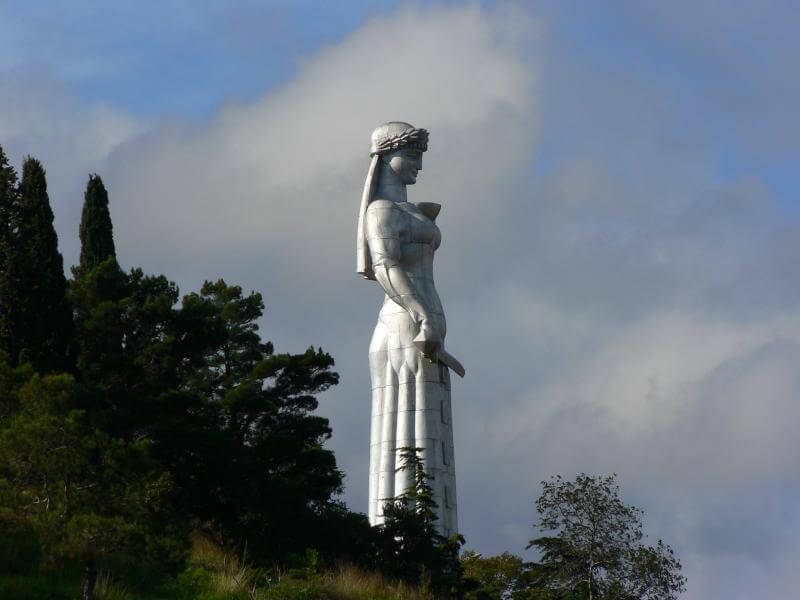
For a very long time Georgian Muslims, which make up 10% of the country’s population held their prayers in 2 mosques. Juma Mosque for Sunnies and the Blue Mosque for the Shiite. However, in 1951, the Blue Mosque was demolished by the Soviet Government to make way for a bridge leaving Shiite Muslims without a place of worship. At that time, the doors of the Juma Mosque were opened on the Shiite Muslims and making it one of the few mosques in which both Shiite and Sunni Muslims pray. Until 1996, a black curtain separated the two groups, but since then Shia and Sunni Muslims have been worshiping alongside each other. The Svetitskhoveli Cathedral is an orthodox church located in the historic city of Mtskheta, in the northwest of Tbilisi. The early medieval masterpiece introduced by UNESCO as a World Heritage Site. The main building of this church dates back to the 4th century, but what we are now witnessing was built in 1029. It is said that the St. Nino a woman who introduced Christianity to Georgia or Iberia, built this monument where the two rivers, the Kura and Aragvi meet. Choosing this place has a long story. In summery, According to Georgian hagiography, in the 1st century AD a Georgian Jew from Mtskheta named Elias was in Jerusalem when Jesus was crucified. Elias bought Jesus’ robe from a Roman soldier at Golgotha and brought it back to Georgia. Returning to his native city, he was met by his sister Sidonia who upon touching the robe immediately died from the emotions engendered by the sacred object. The robe could not be removed from her grasp, so she was buried with it. The place where Sidonia is buried with Christ’s robe is preserved in the Cathedral. Later, from her grave grew an enormous cedar tree. Ordering the cedar chopped down to build the church, St. Nino had seven columns made from it for the church’s foundation. It was further said that from the magical seventh column a sacred liquid flowing through that cured people of all diseases. In Georgian sveti means “pillar” and tskhoveli means “life-giving” or “living”, hence the name of the cathedral. The existence of this church in Mtskheta made it the capital of the country before the king of Vakhtang selected Tbilisi as the capital, which, of course, is known by the Georgians as the religious capital of the country. The church withstood a lot of damage throughout its history but was rebuilt. It is not bad to know that there are important people buried inside the church such as Vakhtang Gergasali, the founder of the city of Tbilsi, the king of Hercules, the king of Kakheti , the first wife of Gorgin Khan, one of the Kartli kings of the time of the Safavids, King David VI of Iberia the eighth Georgi the last of the Iberian king Some members of the royal family. The name of the constructor was Arsukidze. In the outer wall of the northern wall, there stands a magnificent statue of a hand-held hammer, the text underneath it reads: “This is the hand of the Arsukidze, the slave of the Lord, God forgive him.” He never met the completion of his masterpiece and died before the church was completed. The Holy Trinity Cathedral of Tbilisi (Tbilisis cminda samebis sakatedro tadzari) , also known as the Samba, is the main Orthodox church in Georgia, located at the heart of Tbilisi. The construction of this building lasted from 1995 to 2004 It is the third-tallest Eastern Orthodox cathedral in the world and one of the largest religious buildings in the world by total area. Sameba is a synthesis of traditional styles dominating the Georgian church architecture at various stages in history and has some Byzantine undertones The idea to build a new cathedral to commemorate 1,500 years of autocephaly of the Georgian Orthodox Church and 2,000 years from the birth of Jesus emerged as early as 1989, a crucial year for the national awakening of the then-Soviet republic of Georgia. In May 1989, the Georgian Orthodox Patriarchate and the authorities of Tbilisi announced an international contest for the “Holy Trinity Cathedral” project. No winner was chosen at the first round of the contest when more than a hundred projects were submitted. Finally the design by architect Archil Mindiashvili won. The subsequent turbulent years of civil unrest in Georgia deferred this grandiose plan for six years, and it was not until November 23, 1995, that the foundation of the new cathedral was laid eventually finishing construction on November 23, 2004 on the day of the Georgeba (one of the religious ceremonies of Georgia). The dome of this church is 7.5 meters high and is made of gold. The total height of the ground floor is 81.7m underground height is 13 meter. It is interesting to note that this building is not just a single church, but consists of 9 smaller churches. Jvari Monastery s a sixth century Georgian Orthodox monastery near Mtskheta, eastern Georgia Along with other historic structures of Mtskheta, it is listed as a World Heritage site by UNESCO from 1994. Jvari Monastery stands on the rocky mountaintop, overlooking the town of Mtskheta, which was formerly the capital of the Kingdom of Iberia. According to traditional accounts, on this location in the early 4th century Saint Nino a female evangelist credited with converting King Mirian III of Iberia to Christianity, erected a large wooden cross on the site of a pagan temple. The cross was reportedly able to work miracles and therefore drew pilgrims from all over the Caucasus. A small church was erected over the remnants of the wooden cross in c.545 named the “Small Church of Jvari”. Kartlis Deda or the Mother of Georgia was erected on the top of Sololaki hill in 1958, the year Tbilisi celebrated its 1500th anniversary. Prominent Georgian sculptor Elguja Amashukeli designed the twenty-metre aluminium figure of a woman in Georgian national dress. She symbolizes the Georgian national character: in her left hand she holds a bowl of wine to greet those who come as friends, and in her right hand is a sword for those who come as enemies. This square has witnessed many events throughout history. Referred to by the locals as Tavisupleba now a days this lively square has had different names throughout the years. The square was originally named after Ivan Paskevich, the Count of Erivan, a Ukrainian general of the Russian Imperial Army, who earned his title in honor of his conquest of Erivan (present-day Yerevan) for the Russian Empire. Under the Soviet Union, the square was renamed, first “Beria Square”, and then “Lenin Square”. The location was first named Freedom Square in 1918, during the foundation of the First Georgian Republic following the collapse of the Russian Empire. Freedom Square was the site of the 1907 Tiflis bank robbery. Freedom Square has also been the site of various mass demonstrations including those for Georgia’s independence (from the Soviet Union), the Rose Revolution, and others. In 2005 Freedom Square was the location where U.S. President George W. Bush and Georgian President Mikheil Saakashvili addressed a crowd of around 100,000 people in celebration of the 60th anniversary marking the end of World War II During this event, Georgian-Armenian Vladimir Arutyunian threw a live grenade at President Bush while he was speaking in an unsuccessful attempt to assassinate him Tbilisi City Hall is situated on the Square. Other buildings include the former Bank of Georgia head office and the Marriott International Tbilisi. The square will also accommodate the Old Tbilisi local government office, the building works of which are already started. Abutting the north side of Freedom Square is a small open space with a fountain and a bust of Alexander Pushkin. During the Soviet period, the square featured a large statue of Vladimir Lenin, which was symbolically torn down in August 1991 On November 23, 2006, the Liberty Monument depicting St George slaying the dragon, created by Zurab Tsereteli was unveiled in the same place. Rustaveli Avenue formerly known as Golovin Street, is the central avenue in Tbilisi named after the medieval Georgian poet, Shota Rustaveli. The avenue starts at Freedom Square and extends for about 1.5 km in length, Rustaveli is often considered the main thoroughfare of Tbilisi due to a large number of governmental, public, cultural, and business buildings that are located along or near the avenue. The former Parliament of Georgia building the Georgian National Opera Theater the Rustaveli State Academic Theater the Georgian Academy of Sciences Kashveti Church Simon Janashia Museum of Georgia (part of the Georgian National Museum), and Biltmore Hotel Tbilisi among others, are all located on Rustaveli. In 1989, tens of thousands of Georgians gathered before the House of Government on Rustaveli Avenue. An attack by the Soviet Spetsnaz forces killed many protesters in the April 9 tragedy. Despite all its difficulties and tragedies this avenue has flourished as a place for happiness and celebration turning it into
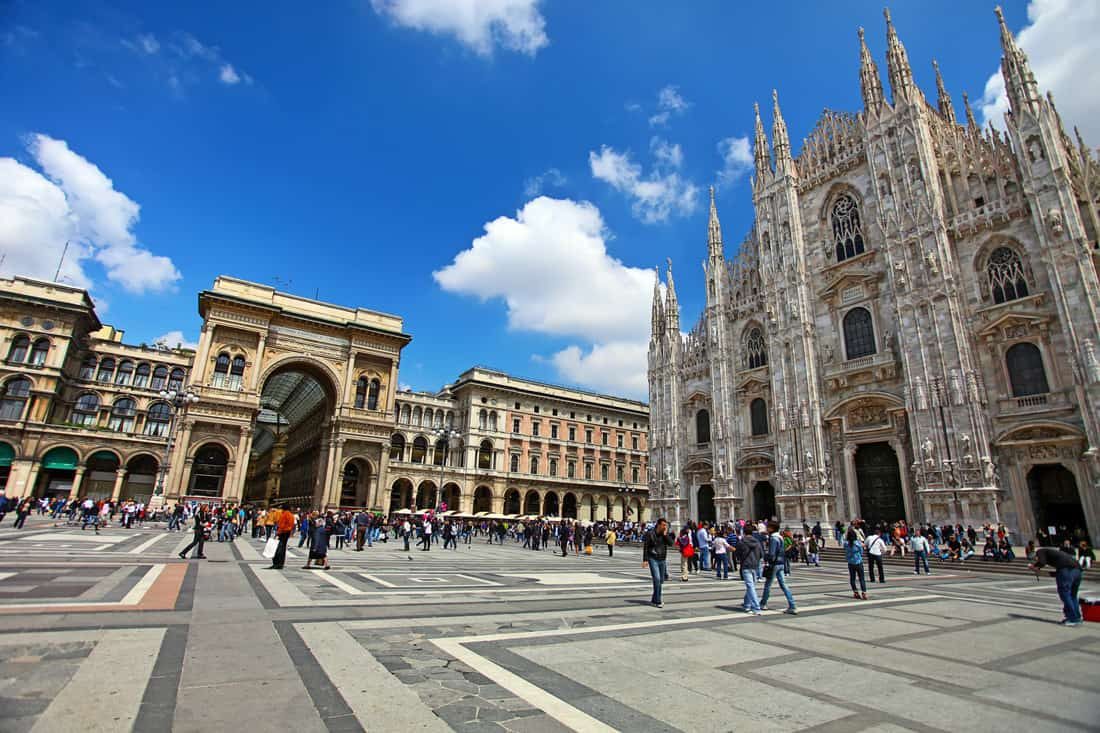
important tourist destination of Tbilisi :
The Tbilisi sea is an artificial lake in the vicinity of Tbilisi that serves as a reservoir. It was opened in 1953 and has become a popular recreation spot. Camping, swimming, fishing and sailing are among the popular activities carried out by thousands of tourists every day. The water park Gino Paradise famously hosts a variety of excellent recreational activities at Tbilisi Sea. It is planned to develop the Tbilisi sea into a recreational park with various sports facilities. The lake has a length of 8.75 km and a width of 2.85 km and for travelers flying into Tbilisi International Airport, it is visible just before landing.
The National Botanical Garden of Georgia, formerly the Tbilisi Botanical Garden is located in the Tsavkisis-Tskali Gorge on the southern foothills of the Sololaki Range it occupies the area of 161 hectares and possesses a collection of over 4,500 taxonomic groups. Its history spans more than three centuries. It was first descri bed, in 1671, by the French traveler Jean Chardin as royal gardens which might have been founded at least in 1625 From 1888 on, when a floristics center was set up, Yuri Voronov and several other notable scholars have worked for the Garden Between 1932 and 1958, the territory around the former Muslim cemetery was included in the botanical garden Several graves have survived however, including that of the prominent Azerbaijanian writer Mirza Fatali Akhundov (1812-1878). The central entrance to the Garden is located at the foothills of the Narikala Fortress. The other, cut through the rock as a long tunnel in 1909-14, had been functional until the mid-2000s when the tunnel was converted into Georgia’s largest nightclub “Gvirabi”.
visit to the breathtaking nature parks of this city. One of most beautiful of these locations is the Turtle Lake. This National Park is located in the suburbs of Tbilisi and is named after the large population of turtle which call it their home. Some know this lake by its Georgian name of Kus Tba. Turtle Lake is located on the wooded northern slope of Mtatsminda Mount at elevation of 686.7m above sea level The Turtle Lake area is designed as a recreational zone and is frequented by the Tbilisians on weekends. It is also a place where festivals and concerts are held It can be reached either via a road or an aerial tramway leading from Tbilisi’s Vake Municipality the tramway is open from 8:00 until 22:00 and costs 1 lari in each direction.
Lisi lake is a small lake in the vicinity of Tbilisi, Georgia. The lake and surrounding area provide a habitat for variety of different species of exotic birds In addition to various avian species, the area around the lake provides shelter to a variety of animals such as turtles, foxes and hares. The area is well known for the large population of snakes the live in the hillsides around the lake. There is a Warm, Mediterranean, and reasonably dry climate in the vicinity of Lisi Lake There is a Warm, Mediterranean, and reasonably dry climate in the vicinity of Lisi Lake This lake is also where the annual Tbilisi Open Air concerts are held.
